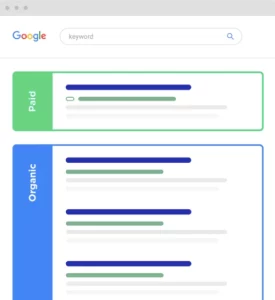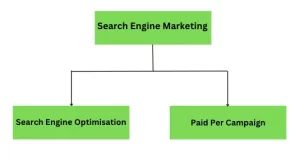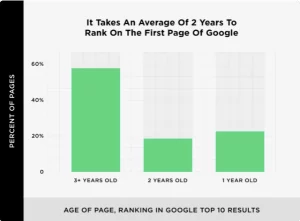Difference Between SEO And SEM – Which Is Better?
In today’s time, a business cannot do without SEO/SEM because it helps increase visibility and attract potential customers to its website, increasing conversions and revenue. Without SEO, a business may struggle to compete in today’s digital landscape and miss out on valuable opportunities. Let’s discuss more in detail about difference between SEO and SEM.
SEO is optimising a website to increase the traffic. On the other hand SEM is to get traffic from organic and paid sources.
“Google only loves you when everyone else loves you first.” – Wendy Piersall.
And if you get this, the rest of the article will be fun to read for you.
What is SEO?
SEO stands for Search Engine Optimization.
It is the practice of optimising a website and its content to improve its visibility and ranking in search engine results pages (SERPs). SEO aims to increase the quantity and quality of organic traffic to a website by making it more relevant and authoritative to the search queries of potential visitors.

For SEO, businesses deploy techniques such as keyword research, content creation, on-page optimization, link building, and technical optimization.
Stat on SEO
Here are some general statistics on Google search results and SEO:
- Google processes over 3.5 billion searches daily, which amounts to around 1.2 trillion searches annually.
- The first page of Google search results receives 95% of all traffic, with subsequent pages receiving significantly less traffic.
- The first organic search result on Google has an average click-through rate of 28.5%, while the second and third organic search results have a click-through rate of 15% and 11%, respectively.
- Websites on the first page of Google search results have an average page authority of 70, while websites on the second page have an intermediate page authority of 50.
- Regarding SEO, some of the most important ranking factors include high-quality content, relevant keywords, backlinks from authoritative websites, mobile-friendliness, and page load speed.
- Local SEO is also important for businesses that serve specific geographic areas, as Google’s local search results are displayed before organic search results.
What is SEM?
SEM stands for Search Engine Marketing. It refers to promoting a website or web page in search engine results pages (SERPs) through paid advertising. SEM involves creating and optimising ads using various advertising platforms, such as Google Ads, Bing Ads, and Yahoo Search Ads, to increase visibility and drive traffic to a website.
SEM allows businesses to target specific audiences based on geographic location, search queries, and user behaviour.

SEM aims to increase the quantity and quality of traffic to a website and improve its conversion rate through targeted and effective advertising.
Stats on SEM
- Search ads can increase brand awareness by 80%.
- Google Ads reach 90% of internet users worldwide.
- The average click-through rate (CTR) for Google Ads across all industries is 3.17% for the search network and 0.46% for the display network.
- Google Ads can increase website traffic by 50% and lead to a 41% increase in click-through rate (CTR) compared to organic search results alone.
- The average cost-per-click (CPC) for Google Ads is $2.69 on the search network and $0.63 on the display network.
Read: How does blogging help SEO?
Difference between SEO and SEM- Which is better for your business?
Let us read difference between SEO and SEM and find which suits better for your business.
| Search Engine Optimisation | Search Engine Marketing | |
| Definition | Improving website visibility through organic search. | Promoting a website through paid advertising in search results. |
| Focus | Organic search results. | Paid search results. |
| Cost | No direct cost for clicks and impressions. | Direct cost for clicks or impressions. |
| Strategy | Long-term strategy | Short-term strategy. |
| Results | Results take time to show. | Results can be seen immediately. |
| Techniques | On-page optimisation, link building, content creation, technical optimisation. | Ad creation, keyword research, bidding strategy, ad targeting. |
| Goal | Improve organic search rankings, increase website traffic, and drive more leads and conversions. | Increase website visibility, drive traffic to the website, and increase leads and conversion. |
Why is SEO and SEM important for business?
SEO and SEM are important for businesses because they help increase website visibility, attract potential customers, and drive leads and conversions. Here are some specific reasons why:
Improved visibility:
SEO and SEM help businesses appear at the top of search engine results pages (SERPs) for relevant search queries. This increased visibility can lead to higher website traffic, brand awareness, and customer trust.
SEO and SEM both help in increasing website visibility in search engine results pages (SERPs) through different methods:
- SEO improves visibility through organic search: SEO involves optimising a website’s content, structure, and technical aspects to improve its ranking in organic search results. By improving the quality and relevance of a website’s content, search engines are more likely to show it at the top of search results for relevant queries, increasing its visibility.
- SEM improves visibility through paid search: SEM involves creating and optimising ads to appear at the top of search results pages. Businesses can target specific keywords and audiences and pay for clicks or impressions to increase their visibility. By creating compelling ad copy and targeting the right audiences, businesses can improve their chances of appearing at the top of search results, increasing visibility.
Increased website traffic:
By appearing at the top of SERPs, businesses can attract more potential customers. SEO and SEM both have the potential to drive high-quality traffic to a website, which can lead to more leads and conversions.
SEO helps increase website traffic by improving the visibility and ranking of a website in organic search results, which can attract more potential customers. Here are some ways that SEO can help drive more website traffic:
- Improved rankings for relevant keywords: By optimising a website’s content and structure for relevant keywords, SEO can help improve its ranking in search engine results pages (SERPs). The higher a website ranks in search results, the more likely users are to click through to the site, resulting in more traffic.
- Better user experience: SEO also involves improving the technical aspects of a website, such as page load speed, mobile-friendliness, and user navigation. Creating a better user experience makes visitors more likely to stay on the site longer and explore more pages, resulting in increased website traffic.
SEM can help increase website traffic by placing targeted ads at the top of search engine results pages (SERPs) for relevant keywords and queries.
Here are some ways that SEM can drive more website traffic:
- Targeted keyword and audience selection: With SEM, businesses can target specific keywords and audiences most relevant to their products or services. By creating ads that align with user intent and needs, businesses can increase the likelihood of attracting potential customers to their sites.
- Increased visibility: By appearing at the top of search results pages, SEM ads can increase the visibility and awareness of a business, which can drive more direct visits to the website.
- Immediate results: Unlike SEO, which can take time to see results, SEM can deliver direct traffic to a website. Businesses can launch ads and see results almost immediately, allowing them to test and refine their campaigns for maximum effectiveness.
- Remarketing: SEM also allows businesses to target users who have previously visited their site or interacted with their brand through techniques such as remarketing. By targeting users who have already shown interest in their products or services, businesses can drive more targeted traffic to their sites.
Targeted marketing:
With SEM, businesses can target specific audiences based on geographic location, search queries, and user behaviour. This allows businesses to reach their ideal customers with relevant messaging and offers.
SEO and SEM can help with targeted marketing by focusing on specific keywords and audiences. Here’s how each approach can help with targeted marketing:
- SEO for targeted marketing: SEO involves optimising a website’s content and structure for relevant keywords and phrases, which can help attract users actively searching for information about a business’s products or services. By targeting specific keywords and creating relevant, high-quality content, businesses can attract more qualified traffic to their site, increasing the chances of generating leads and conversions.
- SEM for targeted marketing: SEM involves creating and optimising ads to appear at the top of search results pages for specific keywords and audiences. By targeting users actively searching for related products or services, businesses can reach potential customers when they are most likely to purchase or take action. SEM also allows for granular targeting based on location, demographics, and search history, which can help further refine ad targeting and improve ROI.
Competitive advantage:
By investing in SEO and SEM, businesses can gain a competitive advantage. They can increase online visibility, attract more customers, and improve conversion rates.
SEO and SEM can help businesses gain a competitive advantage by increasing visibility, driving website traffic and engagement, enhancing targeting and personalization, and creating a better user experience. By optimising their digital marketing efforts, businesses can stand out from competitors, attract more potential customers to their websites, and improve their chances of generating leads and conversions.
By continually refining their SEO and SEM strategies, businesses can stay ahead of the competition and achieve their business goals.
SEM Vs SEO: How Early Can You See the Results?
Sources state that it takes about 2 years to rank in Google.

Though it might take time for businesses to reach higher ranks, the length of time can reduce if proper efforts for search engine optimization and search engine marketing is taken.

Conclusion
In conclusion, SEO and SEM are essential components of a successful digital marketing strategy for businesses.
SEO is a long-term, sustainable approach that requires consistent effort and patience to see results. It optimises website content and structure to rank higher in organic search results.
On the other hand, SEM involves paid advertising and is a more immediate way to drive traffic and conversions. Therefore, it is particularly useful for businesses promoting specific products, events, or promotions.
The decision search engine optimisation vs search engine marketing will depend on the specific goals and needs of the business. For example, SEO is crucial for long-term growth and brand awareness, but SEM can be more effective for short-term results.
A comprehensive digital marketing strategy should include both SEO and SEM to maximise their benefits and drive the best results for the business. If you are willing to escalate the growth of your business, please write to us at hello[at]noboruworld.com.
FAQ
What is the difference between SEM and SEO?
Search engine optimization (SEO) and search engine marketing (SEM) are two approaches to improving a website’s visibility on search engines. SEO focuses on optimising a website’s content and structure to improve its organic search rankings, while SEM involves paid advertising to appear in search engine results pages (SERPs). SEM encompasses a broader range of tactics, including pay-per-click (PPC) advertising, social media advertising, and display advertising.
Which is better, SEM or SEO?
The answer to this question depends on the goals of the website owner. SEO is often seen as a more long-term strategy, as it takes time to build organic search rankings. However, it can also be more cost-effective in the long run, as organic traffic is free. On the other hand, SEM can provide more immediate results, as paid ads can appear at the top of SERPs. However, SEM can also be more expensive, as website owners need to pay for each click or impression.
Should I use both SEM and SEO?
Many website owners use a combination of SEM and SEO to improve their online visibility. Using both tactics, website owners can take advantage of the immediate results of SEM while building a long-term strategy through SEO. Additionally, both tactics can help website owners capture more search engine real estate, as they can appear in the paid and organic search results. However, the specific mix of SEM and SEO that works best will depend on each website owner’s unique goals and resources.



